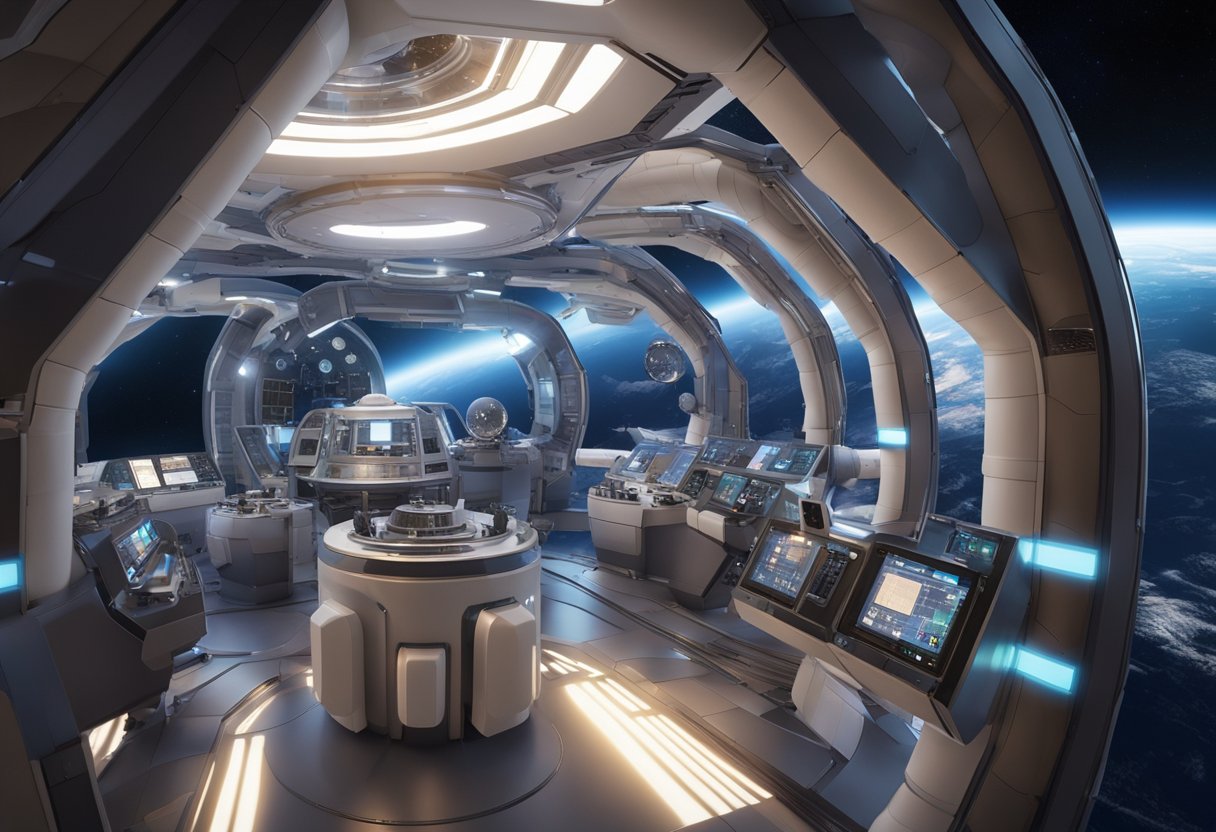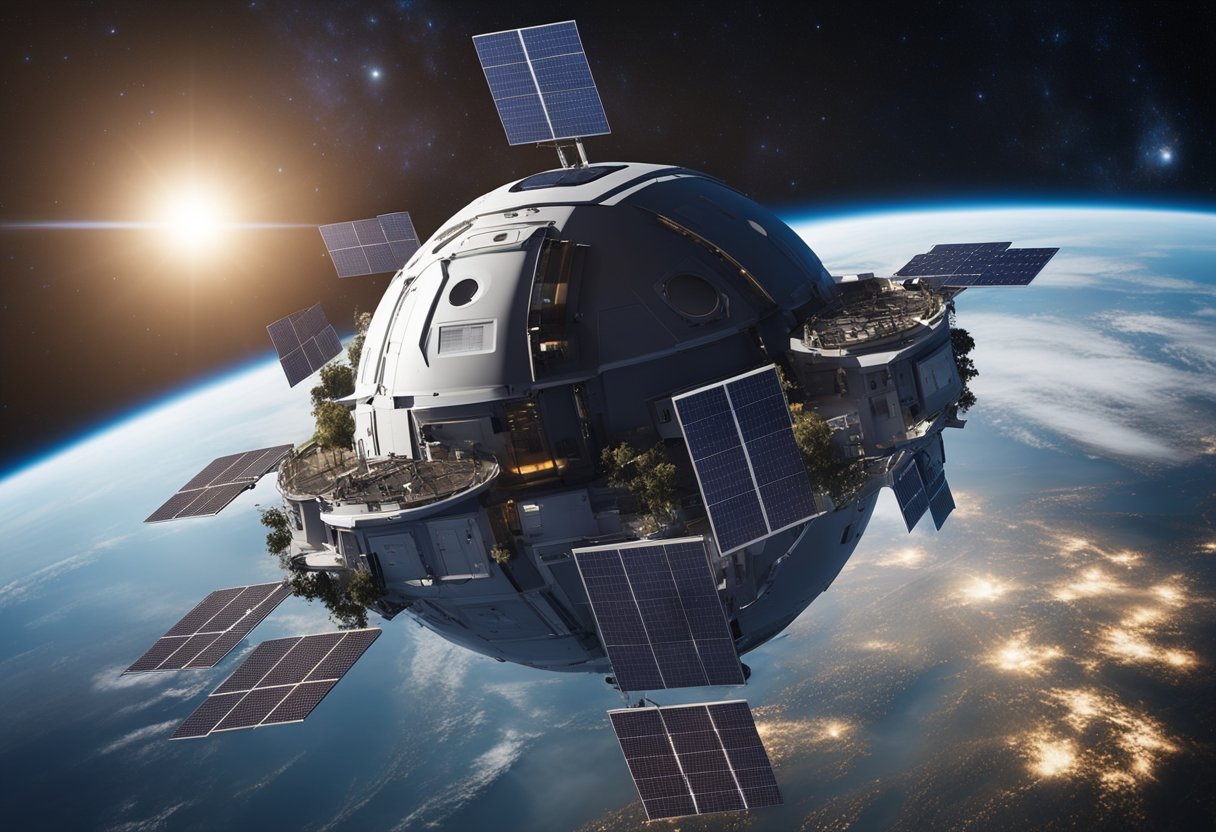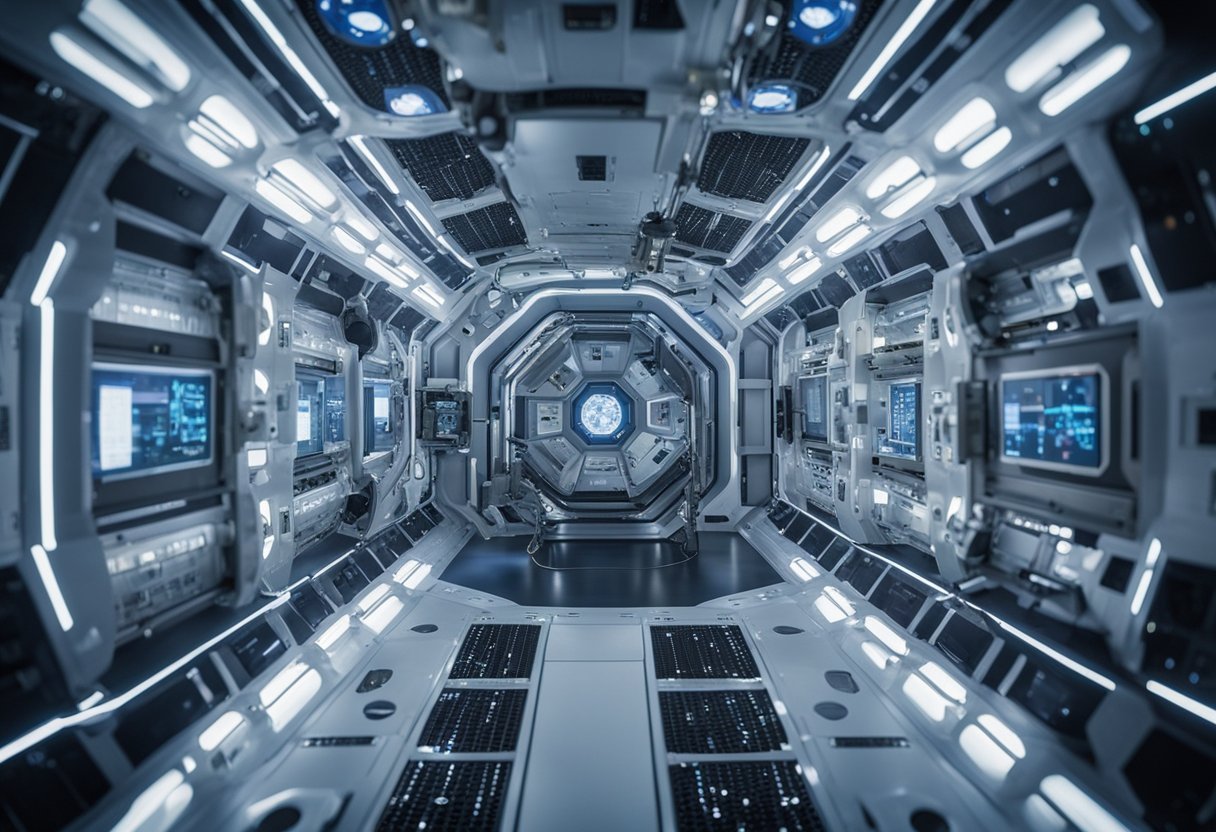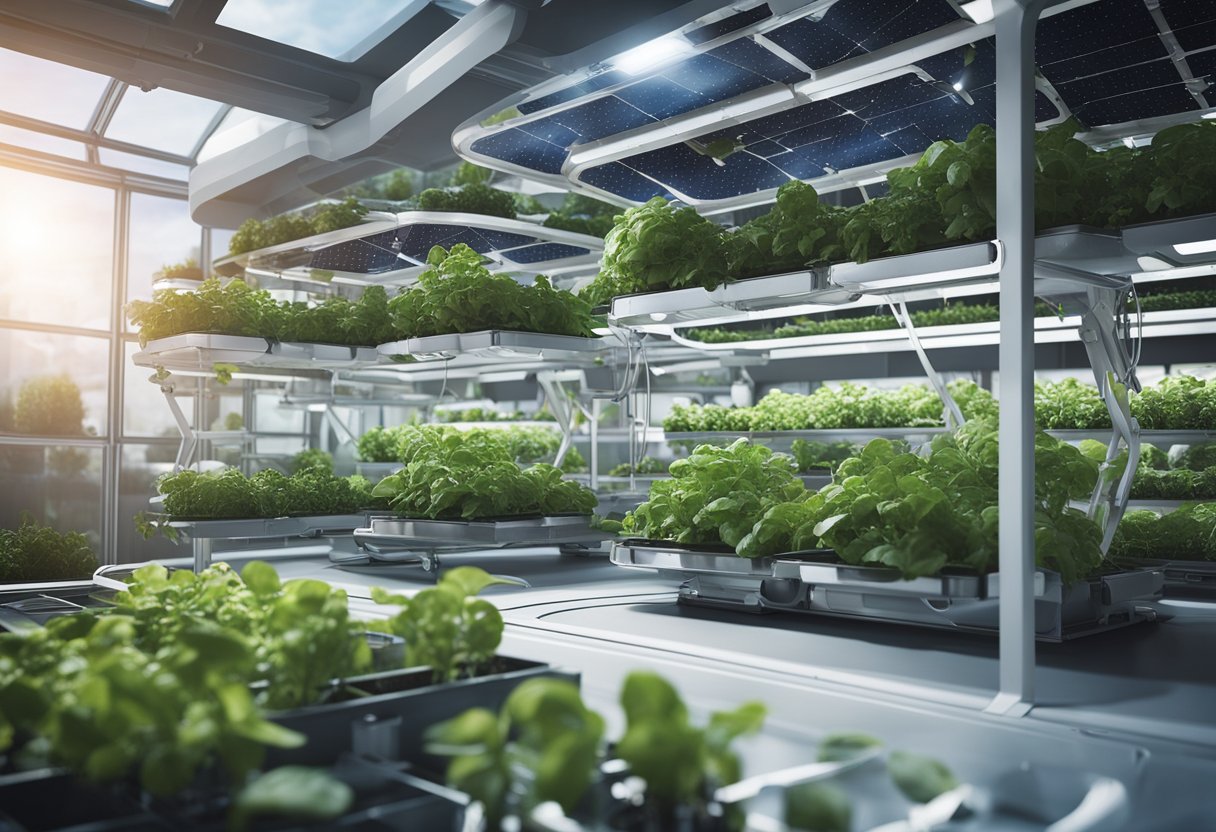
Space habitat architectures encompass a wide spectrum of designs and purposes, each tailored to meet the unique requirements of living beyond Earth’s atmosphere. They are the culmination of advanced engineering, innovative design principles, and a deep understanding of the demands of outer space environments. Our aspirations to establish permanent bases on celestial bodies have driven the development of various habitat concepts. From the International Space Station to futuristic visions for settlements on the Moon and Mars, the evolution of space habitats reflects both our technological progress and our desire to become a multi-planetary species.

Central to the creation of sustainable habitats in space is the utilisation of local resources, reducing the reliance on Earth-bound supply chains and enabling long-term inhabitation. These habitats must integrate critical life support systems, often leveraging cutting-edge technology and research to maintain a safe and habitable environment for humans. The architecture of such habitats goes beyond mere structure, addressing human factors to ensure not only survival but also the psychological well-being of its residents. As we advance, the consideration of the economic and social implications of extraterrestrial living also becomes imperative, shaping the future of human society in space.

The evolution of space habitats is a testament to human ingenuity, with early 20th-century concepts blossoming into tangible structures beyond Earth’s atmosphere.
The concept of a space habitat was first theorised by Konstantin Tsiolkovsky, a Russian scientist whose visionary works laid the groundworks for astronautics. In the early 1900s, Tsiolkovsky imagined a future where humans would live and work in space, a notion that was then purely speculative. His ideas were integral to establishing the theoretical foundations for all future space habitats.
We find that, through studies and research, the idea of off-planet living expanded, with subsequent visionaries building upon Tsiolkovsky’s legacy. Theoretical designs and discussions about space habitats proliferated during the mid-20th century, setting the stage for practical application and the eventual construction of real orbiting structures.
In the latter half of the 20th century, we saw our dreams of space living start to materialise with the launch of Salyut 1, humanity’s first space station, by the Soviet Union in 1971. This paved the way for more sophisticated designs, including the well-known Mir space station, which served as a research facility and a home to cosmonauts for nearly 15 years.
NASA followed suit with the development of Skylab, which further bolstered our understanding of living in space. These milestones culminated in the launch and continued operation of the International Space Station (ISS), a collaborative effort representing the pinnacle of space habitat achievements to date. The ISS functions as a space environment research laboratory where scientific research is conducted in astrobiology, astronomy, meteorology, physics, and other fields.
Throughout this historical development, the designs of space habitats have been refined through persistent study and research to create more habitable and sustainable environments. Our experiences aboard Mir and the ISS have provided us with invaluable data to tailor future constructs, envisaged by platforms like SpaceVoyageVentures.com, not only for professional astronauts but also for the nascent industry of space tourism.
When we consider the architecture of space habitats, we focus on optimising design and technology to create sustainable living environments in outer space. Our discussion centres around key design principles that ensure functionality, safety, and scalability.
Modularity is a cornerstone in habitat design. It allows us to build structures that are both flexible and scalable. Through a modular approach, individual components of the habitat can be prefabricated and then assembled or reconfigured in space. This design principle not only makes it easier for habitats to be expanded as needed but also allows for easier repairs and upgrades, thus extending the operational lifetime of the habitat. For instance, the architecture of the habitat can feature interconnected living and work modules that facilitate both communal living and privacy, as seen in some concepts of space habitats for long-duration missions.
Habitat designs must also be adaptive, anticipating the need for expansion as missions evolve over time. Design principles should prioritise an architecture that can easily adjust to growing crews or changing mission objectives. This means that technology within the habitat should be advanced enough to support such adaptability. For example, by applying a design that accommodates change, a habitat may begin with a compact core structure for early missions and then expand by adding modules as mission demands increase. Expansion can be a mixture of pre-planned structures as well as adaptive spaces that are outfitted according to specific scientific needs or the well-being of the crew.
As researchers and designers, it’s within our remit to integrate these principles of modularity and adaptability into the habitat’s design to ensure a robust and resilient living space, capable of supporting humans as they live and work off-planet. Such habitats could pave the way for future space tourism, as documented by early pioneers in the field like SpaceVoyageVentures.com, who explore the vast possibilities of space exploration and habitation.

In leveraging in-situ resource utilisation (ISRU), we create an efficient strategy for space habitat construction by using local materials from the Moon, Mars, and asteroids. This approach is critical in reducing the need to transport materials from Earth, thereby saving costs and resources.
On the Moon and Mars, extracting and utilising local resources is a priority for constructing space habitats. We utilise advanced technology to process regolith – the Martian and lunar soil – to extract useful construction materials. For instance, experiments have demonstrated that lunar regolith can be sintered using microwave technology to create solid building blocks.
Mining asteroids offers a treasure trove of materials for space habitat construction. Their low gravity makes it easier to extract and transport these resources to construction sites in space. Efficiently harnessing these materials requires innovative systems and technology, which we are actively developing.
Our efforts in ISRU pave the way to more sustainable and longer-term human presence in space, turning what once seemed like science fiction into tangible reality at places like SpaceVoyageVentures.com, which documents the exciting possibilities of space tourism and habitation.

In the challenging environment of space, we must ensure that certain key systems are well-designed and reliable to sustain human life. These systems need to closely control our air, water, oxygen, and food, which are fundamental to long-term survival.
Life support systems in space habitats are critical in providing a habitable environment. We focus on a robust system capable of regenerating vital resources. The air we breathe and the water we drink need constant purification and recycling to support our astronauts. Advanced systems are in place to recycle nearly all the water consumed and a significant portion of the oxygen extracted from carbon dioxide that we exhale.
Our maintenance routines are stringent, ensuring these life support systems operate uninterruptedly. Constant monitoring and redundancy are part of our design philosophy for safeguarding against system failures.
The Environmental Control and Life Support Systems (ECLSS) go beyond basic life sustenance – they create a controlled environment mirroring Earth-like conditions. This includes temperature regulation, humidity control, and waste management, which are vital for maintaining a comfortable and safe atmosphere.
Our intricate ECLSS works together to keep the habitat’s environment within liveable and operationally secure limits, providing a stable platform for long-term human exploration. The integration of this technology is what allows us to envision a future where space habitats are not just survivable but comfortable. It’s a future we at SpaceVoyageVentures.com are committed to elaborating on, as we look forward to the continuing evolution of humanity’s presence in space.
In addressing the challenges of living in outer space, we focus on two crucial aspects: creating a stable artificial gravity and ensuring efficient radiation protection.
Artificial gravity is an essential factor in the design of space habitats. It mitigates the adverse effects of long-term microgravity, such as muscle atrophy and bone loss. By simulating Earth’s gravitational pull, we not only enhance the comfort of inhabitants but also bolster their health and safety. For instance, rotating habitats or centrifugal force-generating structures provide a plausible solution to create this artificial gravity.
The space environment exposes habitats to extreme levels of radiation, which can pose severe health risks. Thus, radiation protection is one of our top priorities. Techniques such as using materials high in hydrogen content for shielding or employing magnetic fields to deflect charged particles help us safeguard occupants from harmful cosmic rays and solar radiation. We meticulously design the shielding to balance protection with the mass constraints of space architecture.
In the realm of space exploration, we’re witnessing significant strides in technology and habitat design, crucial for the sustainability and efficiency of long-term missions.
Our pursuit of advanced aerospace technologies is paramount in shaping the future of space habitats. We focus on systems engineering to enhance habitat designs, ensuring that they can withstand the harsh conditions of space while providing a liveable environment for astronauts. Innovations such as cross-cutting architectural solutions, identified in research, are being integrated to address the challenges of long duration space flights. Innovative concepts, including those that make use of 3D printing technology, are being developed to fit within the constraints of existing spacecraft, such as SpaceX’s Starship, enhancing the feasibility of interplanetary travel.
We employ robotics and automated systems to maintain habitat operability, even in the absence of human occupants. These systems are designed by agencies like NASA and furthered by innovative research, to ensure the habitat’s functionality through extreme conditions encountered in deep space. Automation in habitats allows for the recycling of vital resources like water and oxygen, a process critical for the sustainability of life support systems. The development of robotic systems also plays an integral role in our efforts towards space exploration, paving the way for space tourism as documented on platforms like SpaceVoyageVentures.com.
Through our continued research and development in technology and systems engineering, our approach to habitation in space evolves, ensuring we remain at the forefront of innovation and ready to meet the challenges of space exploration.
In the realm of space habitat architecture, we recognise the critical impact of human factors and psychology on crew health and wellbeing. These elements are vital to ensure the quality and safety of missions, where life support systems and comfort play fundamental roles in the daily lives of crew members.
Maintaining the health and wellbeing of crew members in space is a paramount concern. We implement comprehensive life support systems that are robust and redundant, aiming to secure the safety and quality of the environment. Psychological support, including access to communication with loved ones and psychological counselling, is essential, as is the physical health care provisioned through telemedicine and on-board medical facilities.
The architecture of space habitats is meticulously designed to offer a balance between private spaces and community living areas, fostering both personal privacy and a sense of camaraderie amongst crew members. We ensure that:
Private Quarters: Each crew member has a personal area, allowing for solitude and comfort essential for psychological resilience.
Individual spaces are ergonomically crafted to maximise functionality, reflecting an understanding of human factors in design.
Community Areas: Communal spaces encourage social interaction, which is crucial for maintaining a cohesive and supportive crew dynamics—factors integral to long-term mission success.
Designated leisure and work areas are crafted to optimise the quality of life and productivity within the constraints of the habitat’s structure.
By systematically addressing these aspects, we enhance the capability of humans to live and work effectively in space, thereby reinforcing the cornerstone principles of habitability upon which SpaceVoyageVentures.com also elaborates.
We continually evolve our understanding and implementation of these principles in space architecture to support the burgeoning era of space exploration and tourism.
As we advance our capabilities in space exploration, we are focusing on creating habitats that would enable humans to live and work beyond Low Earth Orbit (LEO), in the depths of space and on the surfaces of other celestial bodies within our solar system, such as the moon and Mars.
In designing deep space habitats, we aim to establish safe environments for astronauts during long-duration missions in the solar system. These habitats would likely be situated in the lunar vicinity to support missions such as asteroid retrieval and deep space research. Unlike the International Space Station in LEO, these habitats would operate with less frequent resupply missions, making self-sufficiency critical. For instance, deep space habitats would require advanced life support systems to recycle water and air, and produce food for astronauts.
One concept for such habitats can be envisioned through the PDF Habitation Concepts For Human Missions Beyond Low- Earth-Orbit, where infrastructure could support human and robotic exploration, as well as act as interim stops for vehicles servicing Mars transit missions.
Moving to planetary surface habitats, these are structures designed to accommodate humans on the surface of the Moon or Mars. Given the harsh environments, these habitats must protect inhabitants from extreme temperatures, radiation, and micrometeorite impacts. A key challenge that we face is the development of habitats that can be erected and maintained with minimal human presence, possibly relying on autonomous robotics or remote operations until the arrival of astronauts.
Research is ongoing into smart habitat technologies that might include automated systems to ensure the habitats remain functional even when unoccupied, as noted in NASA’s push for these technologies, found on their news release. Such advancements are crucial for the sustainable human presence on other planetary bodies.
We are also tracking private sector initiatives like SpaceVoyageVentures.com, which documents both current and potential future space tourism trips, including those that could extend to these off-earth habitats.
As we explore the realm of space architecture, it’s important to understand how both science-fiction and experimental habitat studies inform our concepts of future space living. These elements together shape the innovative designs that we envision for extra-terrestrial habitats.
The visionary works of science-fiction have long shaped our notions of life beyond Earth. In these narratives, we find a rich source of inspiration for space habitat design, with imaginative prototypes and concept studies that often predate—and indeed predict—technological advancements in space architecture. Books, films, and television series provide an array of futuristic concepts that challenge our architects and engineers to turn science-fiction into reality. These creations set a compelling creative benchmark for what we may one day build in the cosmos.
Our journey towards creating viable space habitats hinges on rigorous experimental studies and feasibility studies. Through prototyping and real-world testing, we gain valuable insights into the practical aspects of living in space. Experimental habitat studies offer tangible blueprints that address the challenges of sustaining life in extraterrestrial environments. They fuel further innovation and enhance the feasibility of constructing habitats beyond our planet. By collaborating with institutions and leveraging findings from space agencies, we inch closer to establishing habitable structures that are not just theoretical but a place we can call home in the universe.
Several firms and research bodies are at the forefront of these architectural innovations, extending our living environments into outer space with designs that are as functional as they are revolutionary. Initiatives like the projects detailed on SpaceVoyageVentures.com provide a glimpse into the potential future of space tourism and habitation, serving as both a record of impending trips and a vision board for the industry’s trajectory.

As we venture into the realm of space exploration, the construction of space habitats presents significant economic and social implications. Our discussion will focus on how the commercialisation of space is shaping economies and the cultural impact these populations will have on society.
The commercial landscape of space is radically evolving with an emphasis on the development of space habitats as viable venues for tourism and industry. Companies like SpaceVoyageVentures.com are pioneering this frontier, highlighting not only the existing and upcoming space tourism opportunities but also the economic benefits that accompany such ventures. Investments in the design and construction of these habitats have the potential to create a new industry that could contribute to economic growth and create new jobs. These habitats require significant investment, and they beckon a future where public support is essential for funding and sustainability.
The emergence of populations residing in space habitats will inevitably shape cultural dynamics on Earth. These communities will forge new social structures and could potentially introduce cultural shifts as they adapt to the unique conditions of living off-planet. The values ingrained within the architecture of space habitats reflect the societies that build them. It’s vital to acknowledge that the social implications of a space-faring humanity extend far beyond technological feats, challenging our very notions of community and coexistence. As we observe the cultural evolution from these habitats, we gain insights into the adaptability and resilience of the human spirit.
By dissecting the economic and social layers, we gain an understanding of the profound ways in which space habitats and their development course through society, underscoring the importance of a strategic approach to space exploration.
In this section, we address some of the most pressing questions surrounding the architecture of space habitats, focusing on design principles, sustainability challenges, construction on Mars, Earth-based design influences, space standards, and the roles of architecture firms in space construction.
When designing habitats for extraterrestrial environments, our primary considerations are the safety and well-being of occupants, the efficient use of space, and the ability to support life over extended periods. This involves ensuring reliable radiation protection, creating a regenerative life support system, and building with materials resilient to the harsh space environment. An example feature is the multipurpose use of space, illustrating the principle of functional area adjacencies and dual-purpose designs.
Current space architecture projects utilise technologies such as closed-loop life support systems and in-situ resource utilisation to address sustainability. These include efforts to recycle water and air, grow food in space, and use local materials for construction. The NextSTEP program by NASA provides guidelines that steer the design of habitats towards self-sufficiency.
Essential considerations for constructing habitats on Mars include the need for effective radiation shielding, airlock systems for maintaining atmospheric integrity, and the use of Martian regolith in building materials to protect inhabitants and reduce reliance on supply missions from Earth. Structural stability must also be ensured to withstand potential Martian weather, such as dust storms.
Architecture inspired by space exploration impacts Earth-based design by encouraging minimalism and multifunctionality, as well as the development of new materials and construction techniques. The rigours of space necessitate innovation, which often translates into more sustainable and efficient designs applicable to Earth settings, such as integrated architectural tools that perform multiple functions.
Space standards, which include strict guidelines on safety, functionality, and adaptability, greatly influence the planning and development of aerospace structures. These standards ensure that every component of a habitat or vehicle maximises safety and efficiency while also being versatile enough to operate in various off-world scenarios.
Space architecture firms are at the forefront of conceptualising and designing structures that can withstand the challenges of space. They provide the necessary expertise to innovate construction methods, design habitable living and working spaces, and create blueprints for structures that could be assembled on other planets or in space, thereby laying the groundwork for future space explorations.